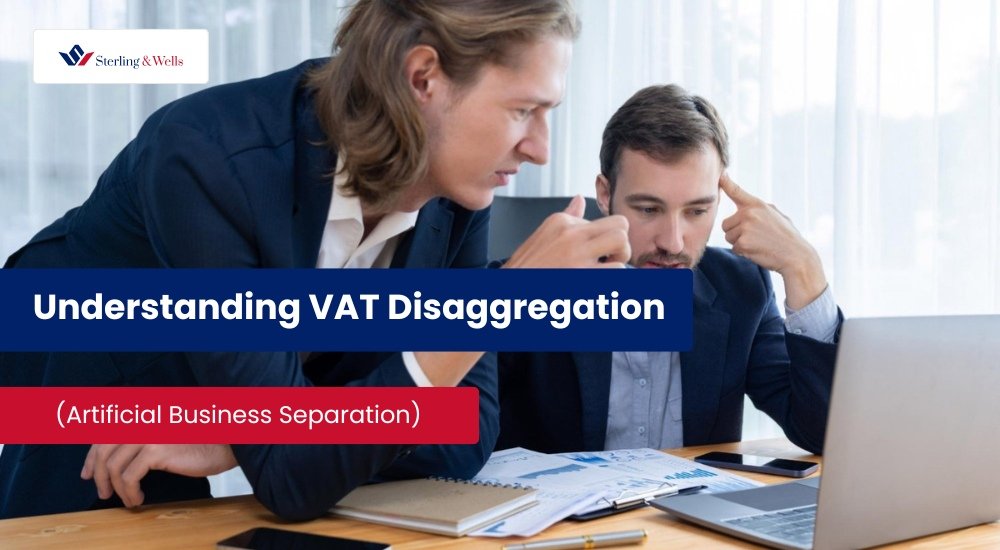Understanding VAT Disaggregation (Artificial Business Separation)

The VAT disaggregation or artificial separation of businesses to gain VAT advantages remains a critical issue for tax authorities. VAT legislation is designed to ensure fair taxation, preventing businesses from manipulating their structure to avoid VAT liabilities. While legitimate business separation is permissible, authorities carefully scrutinize cases where entities appear to function as a single economic unit despite being registered separately.
Rather than focusing on legal structure alone, HMRC considers the overall substance of the arrangement to ensure that VAT registration reflects genuine commercial reality. This article explores how VAT rules address artificial separation, the key indicators tax authorities look for when assessing business independence, and the practical implications for businesses.
What Is VAT Disaggregation
VAT regulations require businesses that exceed the registration threshold to charge VAT on their taxable supplies. Some businesses attempt to remain below this threshold by fragmenting their operations into multiple smaller entities, each registering separately for VAT or remaining unregistered.
Tax authorities and tribunals rely on specific criteria and legal precedents to assess whether businesses are genuinely separate or artificially fragmented. The courts consider both the substance and form of business structures, ensuring that companies do not evade VAT through technical loopholes.
When evaluating artificial separation, tribunals examine operational, financial, and economic links between businesses. A key question is whether the businesses could independently exist or if their separation serves primarily to avoid VAT registration.
Financial Link
Financial connections between entities can indicate artificial separation. Indicators include:
-
Shared financial resources
Whether the businesses use the same bank accounts, lines of credit, or accounting systems.
-
Mutual financial support
If one entity funds or subsidises the operations of another, directly or indirectly.
-
Joint liability
For example, if two businesses have jointly signed lease agreements, loan guarantees, or contracts.
-
Profit and loss sharing
Whether there’s an arrangement to share profits or absorb losses between the entities.
Such links suggest that the businesses do not operate with financial independence and may have been split artificially to remain below the VAT threshold.
Economic Links
Economic links assess how closely the business activities and goals are aligned. Indicators include:
-
Common commercial purpose
If the businesses exist to serve a shared goal or economic outcome (e.g. one generates leads, and the other completes the service).
-
Interdependency of supply
If one business is almost entirely reliant on the other for goods, services, or customers.
-
Overlapping customer base
Where customers perceive the businesses as one or routinely deal with both as part of a single transaction or service.
-
Unified marketing or branding
Businesses that present themselves to the public under one name or coordinated branding are considered economically linked.
These links suggest that the businesses are functioning together in the marketplace and not as distinct, independent operations.
Organizational Links
These involve the management and operational structures of the businesses. Key factors include:
-
Common control or ownership
The same individual(s) own or manage the separate entities.
-
Shared staff
Employees work across both entities without formal separation of duties and contracts.
-
Shared premises or equipment
Businesses operating from the same physical location, using the same tools, storage, or administrative support.
-
Lack of administrative separation
If business records, payroll, invoicing, or communication systems are shared or managed by the same personnel.
The presence of these links suggests the businesses are not operationally independent and might be artificially separated.
If authorities determine that multiple entities are a single economic unit, they can issue a VAT assessment requiring the businesses to be treated as a single taxable person. This can result in significant VAT liabilities, penalties, and reputational risks for affected businesses.
What is Notice of Direction
Once HMRC has gathered all necessary details, it may issue a Notice of Direction if it concludes that the entities involved do not operate at ‘arm’s length’ and are not genuinely independent from one another.

A Notice of Direction establishes a single taxable entity with its own VAT registration number, formed from the partnership of the individuals listed in the notice. This entity is effective for VAT purposes starting from the date of the notice.
Under Schedule 1, Paragraph 2 of the VAT Act 1994, this partnership exists only for VAT purposes. It does not imply the creation of a legal partnership for any other reason and is treated separately from any partnerships that may already exist.
Appealing a Notice of Direction
There is a right to appeal against a Notice of Direction. If applicable, it may be possible to prove that the individuals listed in the notice are not linked financially, economically, or organizationally, but are instead running truly independent businesses.
Usually, an appeal should be submitted within 30 days from the date of the notice. It is advisable to respond promptly and provide appropriate evidence to support the case.
VAT Disaggregation Examples
Whether a particular business separation is considered artificial depends heavily on the unique facts of the case. HMRC assesses various factors such as financial links, economic ties, and how the businesses are structured and managed to determine how closely the entities are connected. That said, HMRC has highlighted certain types of arrangements that are commonly seen as artificially separated or disaggregated. Following are the VAT disaggregation examples:
- Separate Entities Serving Different Customer Types
In this arrangement, one entity is registered for VAT and deals only with VAT-registered customers, while a supposedly separate unregistered entity supplies goods or services to individuals or unregistered businesses. The intention is often to keep the turnover of the unregistered entity below the VAT threshold. This tactic is sometimes seen in service industries, such as consultancy or maintenance services.
- Shared Use of Premises or Equipment
Multiple entities may use the same equipment or operate from the same premises on a rotational basis. For example, on different days of the week or during separate time slots. Typically, one party owns the property or equipment and leases it to the others. This model is common in shared-use businesses like launderettes, or ice cream vans. While the operations may look separate, the close integration and shared resources often raise questions about whether they are genuinely independent.
- Splitting a Single Supply into Separate Components
Some businesses divide what is usually considered a single supply into two or more entities. A common example is a bed and breakfast service where one business charges for the room and another for the meals. Similarly, in the horse livery business, one entity might charge for the stable while another sells the feed. While this can occur legitimately, HMRC will assess whether such arrangements are commercially meaningful or artificially structured.
- Businesses That Appear as One to the Customer
Sometimes businesses are structured so that, despite legal separation, they function and present themselves as a single enterprise to customers. For instance, a pub may claim that the bar and kitchen are run by different entities, but customers perceive them as part of one pub experience. Unless the businesses are genuinely distinct and independently operated (e.g., a franchise with its own branding and operations), HMRC may consider this a single business for VAT purposes.
- Common Control Across Similar Businesses in Different Locations
This situation involves the same individual controlling multiple businesses that offer identical goods or services from various locations—such as multiple salons, retail outlets, or takeaway shops. Even if each outlet is operated by a different company, if they share ownership, control, and business strategy, HMRC may treat them as one business. This is especially relevant where each entity’s turnover is just below the VAT registration threshold, raising concerns of deliberate structuring to avoid VAT.
VAT Disaggregation Rules
To avoid legal and financial risks, businesses should consider the following VAT disaggregation rules:
Maintain Financial and Operational Independence
Businesses must ensure that separate entities have distinct financial accounts and autonomous management.
Avoid Common Control Structures
Shared decision-making, financial dependencies, and centralized operations may trigger scrutiny from tax authorities.
Ensure Compliance with VAT Regulations
Consulting tax professionals and structuring businesses in accordance with legal requirements is essential to mitigate risks.
Conclusion
Artificial separation of businesses to avoid VAT obligations is a serious compliance issue that can lead to significant financial consequences. While structuring businesses to suit operational needs is entirely legitimate, it is crucial to ensure that any separation is genuine and reflects commercial reality, not a means to sidestep VAT registration.
Businesses should regularly review their structures for potential financial, economic, or organizational links that may give the impression of a single taxable entity. Seeking professional advice and maintaining clear separation in operations, ownership, and finances can help minimize risk and ensure alignment with HMRC’s expectations.
Sterling & Wells
We are Sterling & Wells — a UK-based team of accountants and tax advisors helping individuals and businesses stay fully HMRC compliant. From VAT and bookkeeping to self-assessments and tax planning, we’ve got your finances covered.